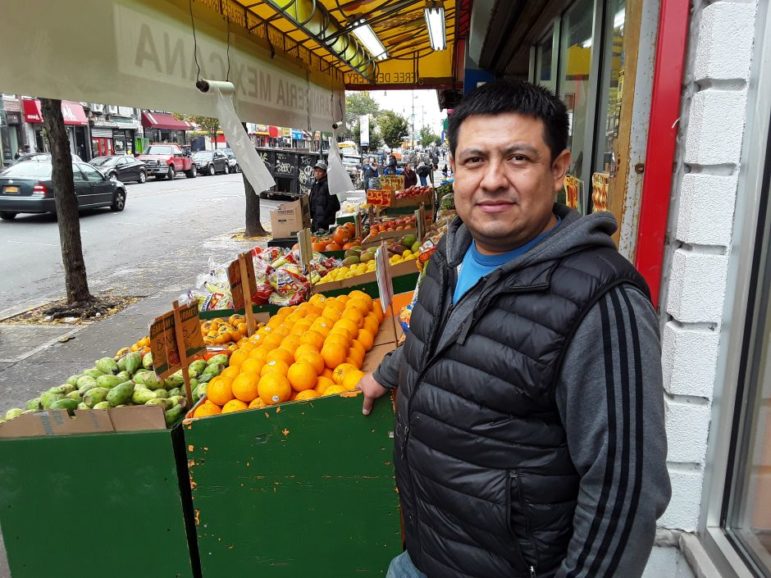
Fernando Martínez
Residents of immigrant-rich neighborhoods like Sunset Park, Brooklyn, say they’re noticing a decline the in the Mexican-born population.
Read the original story in Spanish at El Diario
Translated and condensed by Carlos Rodríguez Martorell
“Many compatriots no longer want to come, and others are leaving,” said Mexican-born Cristian Galindo, standing at the corner of the Sunset Park supermarket where he works, an area known for being one of the Big Apple’s largest enclaves of immigrants from his country. His statement echoes a number of recent studies stating that Mexican migration to the U.S. is showing clear signs of deceleration.
Galindo came to New York in 1995 when he was 16 years old. In those days, most of his friends and family in Puebla were fighting for the “American Dream” in the city. Today, he is convinced such aspiration has vanished.
Figures from the American Community Survey indicate that New York State has seen a decrease in the number of incoming Mexican migrants, with an average rate of 24,625 people per year in the last five years.
Similarly, a 2019 report by Pew Research Center states that “the number of Mexican unauthorized immigrants has fallen by 2 million since its peak of 6.9 million in 2007 and was lower in 2017 than in any year since 2001.”
New York State ranked third among states with the largest decline in its Mexican immigrant population in 2017, accounting for 27,196 of the 304,000 Mexicans who left the U.S. that year. The two states that saw the largest decline were California, which lost 137,352 people, and Texas, with 55,232.
The Center of Latin American Economics Studies (Centro de Estudios Monetarios Latinoamericanos, or CEMLA,) based in Mexico City, provides insight on yet another trend: a record number of Mexicans who have returned to their country since 2017 for various reasons.
Economist Jesús Cervantes, CEMLA’s statistics director, explained to El Diario that it is important to take into consideration several factors in order to understand these dynamics, including that “Mexicans die too.”
According to recent figures cited by Cervantes, some 80,000 Mexican immigrants died last year in the U.S. “This decrease in mobilization has other implications: this immigrant community is growing old,” he said.
Around 7,440,523 Mexican immigrants came to the U.S. between 1990 and 2007. “In 2007, that surge stopped abruptly, and between 2008 and 2018 it was negative, with an average of 52,000 leaving every year,” Cervantes summarized.

Voices of New York spotlights ethnic and community reporting from around the city. Click here to read more.
Residents in Brooklyn’s Sunset Park are beginning to perceive the decrease, despite the fact that norteña Mexican music blasts in the streets and tortillas and guacamole are sold on almost every block.
“More Mexicans and other Hispanics used to live here when I arrived 25 years ago. Now, many people have been scared away by the high rental prices. They don’t want to have to toil here in New York only to be unable to save anything to send back to our country,” said Teresa Suniaga, 62, who came from Zacatecas.
Studies also suggest that the anti-immigrant climate in the last three years, since President Donald Trump has been in power, may be one of the many variables explaining the demographic phenomenon.
Sunset Park was in fact the area where the Mayor’s Office of Immigrant Affairs registered the highest number of ICE raids after the federal government announced a crackdown across the country last year.
Galindo, however, does not link his compatriots’ departure to a fear of “la migra.” Instead, he believes Hispanic residents are “running away from high prices,” in the area, adding that the monthly rent for a small apartment is at least $2,500.
“My people don’t want to work just to pay the rent. Here in the city, saving is impossible. I do not think people are leaving because of the raids. That is not new. The problem is that it is impossible to have a dollar left at the end of the month.”
Toribio González came to the city 42 year ago. Now 68 and a U.S. citizen, he said he’s seen a waning interest among those back home in coming to New York.
“It used to be that your friends from Mexico would call you up all the time to ask if there were any opportunities over here. They wanted to come no matter what to make some money,” he said. “But in the last couple of years, they are choosing to get out of the countryside and move within Mexico. It is makes more sense to them.”
“I have many friends who, for instance, have left Puebla to work the fields for U.S. companies in Mexico in places such as Sonora. They are doing well, so they prefer not to come to this city, where everything is more expensive,” he said.
The generation born in New York of Mexican parents may see things differently.
Edgar Juárez, 23, works as a flagger for a construction company in Lower Manhattan. His parents came to the city 40 years ago from Puebla seeking a better life. He said that, through their hard work, they have made it.
“I think that you can make good money in New York if you work hard. Many Mexicans are moving to smaller cities nearby, such as New Jersey or Long Island, in order to pay less rent,” he said. “But I know of many people who are still coming. I think you can do anything here.”








